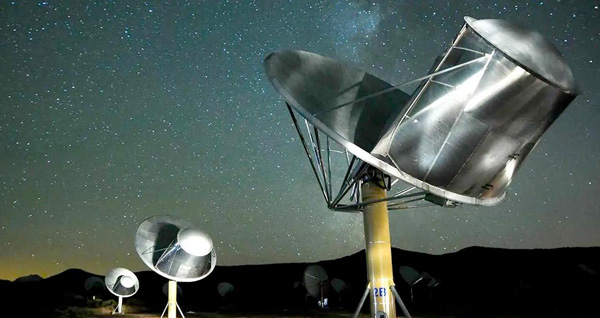An international team of researchers looking for signs of intelligent life in space have used artificial intelligence to reveal eight “promising” radio signals in data collected at a US observatory, a leading scientist at Jodrell Bank has said.
Writing for The Conversation (theconversation.com) Prof Michael Garrett, the Sir Bernard Lovell chair of astrophysics and director of Jodrell Bank Centre for Astrophysics, said the research, published in Nature Astronomy was “remarkable”.
The paper suggested the signals had “many of the characteristics” that would be expected if they were artificially generated.
“In other words, they are the kinds of signals we might pick up from an extra-terrestrial civilisation broadcasting into space,” Prof Garrett.
He said: “A cursory review of the new paper suggest these are indeed promising signals. They’re much more compelling than what is perhaps the most famous Seti candidate, the ‘Wow!’ signal, radio emission bearing the hallmarks of an extra-terrestrial origin that was collected by an Ohio telescope in 1977.”
But before anyone gets the idea that Jodrell Bank will soon be swapping selfies with little green men, Prof Garrett added: “Realistically, it’s most likely that these eight new signals were generated by human technology.
“The real story here is the effectiveness of AI and the techniques used by the team to dig out rare and interesting signals previously buried in the noise of human-generated radio frequency interference, such as mobile phones and GPS.”
He explained that astronomers working in the field of Seti (the search for extra-terrestrial intelligence) had to filter out interference produced by radio communications here on Earth.
In this case, Peter Ma from the University of Toronto and his colleagues ran a set of algorithms on a “mountain” of data collected by the Green Bank Telescope in West Virginia, US. The data was gathered through a Seti initiative called Breakthrough Listen, established in 2015 by investor Yuri Milner and his wife Julia.
The characteristics astronomers look for in signals that could be artificially generated are that they are narrow-band, which means that where the radio transmission is confined to only a few frequency channels; they disappear as the telescope is moved to another direction in the sky; and they exhibit Doppler drifting, where the frequency of the signal changes in a predictable way with time. Doppler drifting would be expected because both the transmitter — on a distant planet, for example — and the receiver, on Earth, are moving.
Any artificial signals from deep space need to be distinguished from radio interference here on Earth.
Prof Garrett said the Breakthrough Listen project’s first candidate signal, called BLC1, was first announced in 2020 but later traced to transmissions associated with cheap electronic devices on this planet rather than advanced alien technology.
Prof Garrett wrote: “The application of AI techniques to the Breakthrough Listen observing programme is a potential game-changer for the field. Even seasoned Seti researchers are beginning to think that we might be on the cusp of a momentous scientific breakthrough.
“This may explain renewed interest by groups around the world that are planning for Seti success. For example, a Seti post-detection hub has been set up at the University of St Andrews in Scotland. This will study how humans should react if we discover we are not alone in the Universe.”
The International Academy of Astronautics Seti permanent committee oversees the Seti post-detection protocols, which outline what steps scientists should take in the event of detecting a genuine signal. The academy has opted to update the text of the protocols sometime later this year.
Gone
The new study highlights a problem with previous signals of interest, Prof Garrett added. When the team took another look at the stars associated with the eight narrow-band transmissions, they could no longer detect the signals.
He wrote: “It would not be surprising if many, and perhaps the vast majority of bona-fide Seti signals, were isolated events. After all, what are the chances that we point our telescopes in exactly the right direction, at the right time and with the right frequency on multiple occasions?
“Seti surveys would greatly benefit from employing multiple radio telescopes, operating in a manner that’s known as a classical interferometer network.
“These telescope arrays (groups of several antennas observing together) generate huge amounts of data. With AI onboard, the challenge is perhaps more manageable than previously thought.”
Breakthrough Listen is already using telescope arrays such as MeerKAT in South Africa for Seti searches. In Europe, researchers have been experimenting with arrays that span the globe. He said The Square Kilometre Array radio telescope project – which is based at Jodrell Bank – could be a mainstay of Seti in coming years.
“This European approach would help us isolate signals from human-made interference, give us multiple independent detections of individual events, and permit us to localise signals to individual stars and possibly orbiting planets,” said Prof Garrett.
The Square Kilometre Array is an international project to build the two largest telescope arrays in the world, which will be based in Australia and South Africa. Its headquarters, are located at the Jodrell Bank Observatory.
The Wow! signal was a strong narrowband radio signal detected on August 15, 1977, by Ohio State University’s Big Ear radio telescope in the United States. The signal appeared to come from the direction of the constellation Sagittarius and bore the expected hallmarks of extra-terrestrial origin.
Astronomer Jerry R Ehman discovered the anomaly a few days later while reviewing the recorded data. He was so impressed by the result that he circled on the computer printout the reading of the signal’s intensity, “6EQUJ5”, and wrote the comment “Wow!” beside it, leading to the event’s widely used name.
It has not been detected since and no-one has adequately explained the signal.
Prof Garrett added: “It’s my belief — and indeed hope — that somewhere out there, intelligent beings are waiting to be discovered. The AI revolution might be the missing ingredient that previous endeavours have lacked.”















